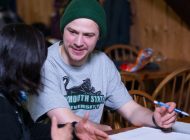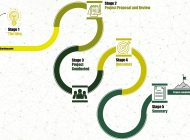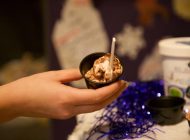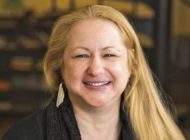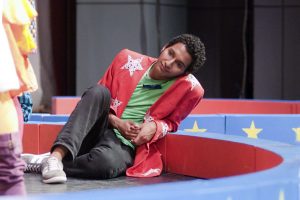Professor of Education Marianne True is considered among the Granite State’s finest educators; she received the New Hampshire Teacher of the Year award in 1989, the New Hampshire Excellence in Education (or EDie) Award in 2003, and PSU’s Distinguished Graduate Teaching Award in 2005. She is a leader in K–16 professional development at the state and national levels. Her scholarship, which has been presented to national and international audiences, involves interactive learning, leadership, and strategies to engage the English language learner. Last year, True was awarded the Stevens-Bristow Professorship, which was established by Wallace ’62 and Meredith Bristow Stevens ’62.
Plymouth Magazine recently spoke with True about her passion for teaching and her inspiration for giving her students a voice in their education.
Q: When did you realize you wanted to be a teacher?
I knew from the time I was in 8th grade that I wanted to be a teacher. I’m one of six children. Three of us did very well at school, and three of us didn’t like school at all. They had difficult relationships with teachers and administrators, and were given the impression that they weren’t “college material.” Even at the age of 13, I found it fascinating that we all came from the same family, yet had such strikingly different experiences in school.
During my student teaching experience, I became passionate about working with students who were considered “at risk” academically, socially, or behaviorally. Early in my career, I was asking, “How do we motivate these students? How do we let them know they have something to offer in school and in other environments?”
Q: When did you come to Plymouth State?
I actually got my master’s here, and later my Certificate of Advanced Graduate Studies while I worked full-time as a principal. Ginny Barry, who was then the chair of the education department, encouraged me to get my doctorate and eventually I joined the faculty here. I started teaching at PSU in 1999, initially at the graduate level, but over time I realized how much fun it was to teach at the undergraduate level. I was really excited to focus on K–8 teacher preparation, which is what I do now.
Q: In 2005, the education department introduced clusters to its childhood studies curriculum. What are clusters, and how do they benefit the students in them?
When we were looking into revamping the childhood studies curriculum a few years ago, I wanted to find a way to empower students, create collaborative communities of students, and better prepare our pre-service educators to meet the needs of public schools. That’s where the idea of clusters evolved.
The students complete their general education requirements in their first five semesters. During that time, they are also introduced to the core components of our program, through courses like Introduction to Childhood Studies, or a special education course, or a human development course. This allows them to spend time in schools observing and having short practicum experiences.
They enter Cluster One in their sixth semester. Cluster One students take all the same classes at the same time, creating a cohort of students. I’m working with 16 phenomenal students right now in a cohort. We meet Monday through Thursday and they spend Friday in the schools. They plan, revise, and share syllabi, talk with each other about what they’re learning in their classes or experiencing in their practica. We want them to be able to share their research and their practice to benefit children.
We deliberately create opportunities inside and outside of the classroom for them to collaborate. Last year’s cohort had its own Facebook page. We also have social gatherings—early on, I have them over to my house. We buy food and they cook and serve it. It helps break the ice so they can really connect with each other.
Then they move to Cluster Two, which is more method-related: How do you teach science in an elementary school? How do you teach reading? Then they go on to student teach in their senior year.
Q: Do the faculty members who are teaching the clusters take the cohort approach as well?
Yes, we are definitely a cohort. And I hold that very dear. We plan together, we meet regularly, and we discuss how each cohort is doing.
Q: Last year you were named the Stevens-Bristow professor of education. It recognizes excellence in preparing the next generation of teachers for careers in education. What does this professorship mean for you?
It was very humbling for me to receive the professorship—I was speechless when I learned about it. It’s a three-year professorship that gives me the opportunity to explore my own professional development and consider how to enhance the work I do. All I’ve ever wanted was to be a better teacher.
Kindra Clineff photo.
Tags: childhood studies clusters Marianne True Stevens-Bristow Professor of Education teacher preparation teacher training







